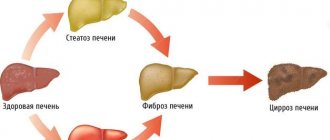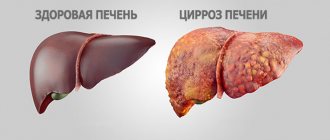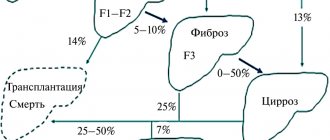Many diseases are accompanied by an increase in the size and weight of the liver. Hepatomegaly (literally “large liver”) is an integral part of various pathologies, since the organ is involved in all biochemical processes of the body.
Liver hepatomegaly is not a disease, but a symptom of a primary or secondary lesion. It is identified by certain objective signs. Therefore, we immediately warn those who are interested in what this diagnosis means: you should not look for it in the classification of diseases as a separate nosology; it is taken into account in the “Symptoms and Syndromes” section.
Criteria for defining hepatomegaly
We are already so accustomed to the most objective assessment of the size of the liver based on the results of ultrasound or computed tomography that we forget that the first signs of hepatomegaly are determined by the attending physician using the ancient methods of palpation and percussion.
Normally, when examining an adult by percussion, the diameter of the organ along the right midclavicular line should not exceed 12 cm. The lower edge of the right lobe can be palpated in incomplete people; it is soft and slides along the doctor’s fingertips.
In relation to the right costal arch, a protrusion of 1–2 cm is allowed. This is typical for people of asthenic physique. The left lobe of the liver is not palpable. It is located in the upper part of the epigastrium behind the stomach. If a dense formation can be identified in this area, then hepatomegaly can be suspected.
To be sure that the liver is enlarged, the doctor needs to exclude prolapse of the organ in chronic bronchitis and severe pneumosclerosis. An unclear compaction due to a tumor of the kidney, intestines, or enlarged gallbladder may be mistaken for the right lobe of the liver.
In addition to the size, the doctor pays attention to the shape and density of the edge (sharp, rounded, “rocky,” “lumpy,” soft), and the presence of pain during palpation.
..
Classification
When making a diagnosis, the condition is classified from an anatomical and morphological point of view. The following types of damage are distinguished:
- bile ducts;
- parenchyma;
- connective tissue;
- vascular network.
In addition, during the diagnostic process it is noted whether hepatomegaly is combined with jaundice , enlarged spleen or ascites .
Hepatosplenomegaly is an enlargement of the liver and spleen. This condition can occur in a number of diseases and conditions. These are liver diseases, infectious and parasitic diseases, metabolic diseases, etc. Since an enlarged liver and spleen is a typical manifestation of many diseases, it is very important to promptly identify this condition and conduct additional examinations.
Taking into account the degree of liver enlargement, the following types of hepatomegaly are distinguished:
- Moderate – the size and structure are slightly changed. Moderate hepatomegaly is the easiest to treat.
- Pronounced - the organ is enlarged by 10 cm relative to the norm.
- Diffuse – an increase of more than 10 cm.
Partial hepatomegaly is distinguished separately, which is characterized by an uneven increase - the process affects only a part or one lobe.
Depending on the reasons for the development of such a pathological process, the following forms are distinguished:
- Drug injury – develops as a side effect when using certain medications.
- Toxic damage - occurs as a result of the influence of toxins - household (polluted air), natural (consumption of poisonous mushrooms), industrial (work in hazardous enterprises).
- Alcoholism is a very common form. fatty liver , alcoholic hepatitis , fibrosis , and cirrhosis can develop .
- Viral infection - occurs due to infection with hepatitis B and C.
- Infectious lesions - characteristic of mononucleosis , hepatitis A.
- Immune damage is a consequence of malfunctions in the immune system, when antibodies “erroneously” act on the liver.
- Cancerous lesion is a consequence of oncological processes. It can develop with ineffective treatment of hepatitis and cirrhosis .
- Dystrophic damage is a consequence of changes in the volume of liver cells and the accumulation of fat in them. This type of injury is called hepatic coma and can be fatal.
What causes the pathology?
The causes of hepatomegaly are very diverse. They are associated both with diseases of the liver itself and with other pathologies. Most often, organ enlargement is caused by the following liver diseases:
- viral and non-viral hepatitis;
- hepatosis (fatty hepatosis is a common pathology in obese people), alcoholic and non-alcoholic fatty degeneration;
- tumors (adenoma, hemangioma, carcinoma, cancer metastases from other organs, focal hyperplasia);
- formed cysts;
- amyloidosis;
- liver enzymopathy (with lysosomal lipase deficiency, hepatomegaly appears in 87% of cases);
- Gaucher disease, which causes fat accumulation;
- cirrhosis with irreversible fibrotic disorders with necrosis of hepatocytes;
- thrombosis of the hepatic veins, blockage of the bile ducts due to inflammation of the bladder.
Hepatomegaly is caused by chronic infections and intoxications. The liver ensures the neutralization of toxic substances and poisons; some pathogens “settle” directly inside the organ: with malaria, echinococcosis, granulomatous hepatitis develops with tuberculosis, sarcoidosis, cytomegalovirus infection, mononucleosis, septic pericarditis.
With decompensation of cardiac activity in the liver, venous blood of the inferior vena cava system is retained, the organ swells, a long process causes compression of hepatocytes and their necrosis, followed by replacement with fibrous tissue, cardiac cirrhosis of the liver is formed
Since the liver suffers from pathology associated with metabolic disorders, hepatomegaly is found in hemochromatosis (iron deposition in cells), Wilson-Konovalov disease (copper particles are found in hepatocytes).
Decompensation of cardiac activity caused by right ventricular failure contributes to overflow and increased pressure in the inferior vena cava and its basin. A congestive type of hepatomegaly is observed:
- with the consequences of acute myocardial infarction;
- myocardial dystrophy;
- cardiomyopathies;
- heart defects.
Hepatomegaly is most pronounced in malignant tumors of the lymphatic system (leukemia, leukemia). In this case, foci of additional extramarrow hematopoiesis are formed in the liver or the tissue is saturated with lymphoblastic cells. The liver reaches enormous sizes, occupies most of the abdominal cavity, and its weight reaches 20 kg.
Treatment with folk remedies
For hepatomegaly, any folk remedies should be used very carefully and in no case should they replace the main treatment. Before using any traditional method, you should consult your doctor about the advisability of its use. In addition, traditional methods also have certain contraindications.
- Milk thistle tea . This medicinal plant protects liver cells and promotes the regeneration of new ones. Also acts as an anti-inflammatory agent. The main active component of the plant is silymarin, which is part of a number of hepatoprotective drugs. To prepare milk thistle tea, you need 1 tsp. Pour 200 ml of boiling water over the seeds of the plant. After half an hour, strain and drink warm in two doses.
- Infusion of immortelle . The inflorescences of this plant contain a lot of flavonoids that have hepatoprotective activity. The use of products with immortelle helps restore the detoxification function of the liver. To prepare an infusion of immortelle, add 10 g of flowers to 250 ml of water and heat the container in a water bath for half an hour. After 10 minutes, strain and squeeze. Add water so that the total amount of product is 250 ml. Drink in 4 doses throughout the day.
- Rose hip decoction . Rose hips also contain many flavonoids. Rosehip helps eliminate spasms of the bile ducts, has a beneficial effect on the digestion process, and produces an anti-inflammatory effect. To prepare a decoction, add 200 g of berries to 1 liter of water, bring to a boil and cook for 15 minutes. Strain, drink 150 ml 4 times a day.
- Collection of herbs . This collection may include oregano, nettle, chamomile, calendula, centaury. Herbs should be mixed in equal proportions and an infusion should be prepared by pouring 2 tsp. mixture 250 ml water.
- Beetroot, pumpkin . These vegetables should be included in the menu more often, preparing a variety of dishes from them. Raw pumpkin is beneficial, as is freshly squeezed beet juice.
How does hepatomegaly syndrome manifest?
During examination, the doctor identifies signs of hepatomegaly and interprets them in favor of one or another diagnosis. For example,
- the “stony” consistency of the edge of the liver, the bumpiness of the surface indicate the likelihood of cirrhosis or a tumor (new cells grow faster, so bumps form);
- pain on palpation is more typical for hepatitis (inflammation), moderate sensitivity of the edge is observed with steatosis;
- rapid enlargement of the organ is typical for the development of cardiac decompensation, with the capsule stretching, which is accompanied by pain;
- The course of liver abscess and hydatid cyst is distinguished by severe pain.
Pain in the liver area
With a significant enlargement of the liver, the patient experiences the following symptoms of hepatomegaly:
- heaviness, constant bursting pain under the ribs on the right or in the epigastrium, radiating to the side, right side of the abdomen, intensifying with movements;
- an increase in abdominal volume due to the accumulation of fluid in the abdominal cavity (ascites);
- itchy skin rashes;
- yellowing of the sclera and skin;
- nausea, heartburn;
- bowel dysfunction (alternating diarrhea and constipation);
- small angiomas on the skin of the face, chest, abdomen in the form of “spiders” or spider veins.
Jaundice is one of the possible symptoms of pathology
Specific symptoms depend on the cause of hepatomegaly. With hepatitis, the patient's liver enlarges evenly, a thickening appears, which is felt along the lower edge. Palpation is painful. There is yellowness of the skin, signs of general intoxication and inflammation (fever, weakness, headaches, dizziness).
Treatment of hepatomegaly caused by viral hepatitis requires antiviral agents and immunostimulants. With good efficiency, the liver returns to normal size. Cirrhosis differs from hepatitis in the mechanism of destruction of liver tissue. Due to diffuse changes in the liver with areas of necrosis, working hepatocytes are replaced by scar tissue.
Impaired functions are accompanied by a tendency to bleeding, the skin takes on an earthy tint, and ascites grows due to portal hypertension. An expanded venous ring with outgoing vessels in the form of a “jellyfish head” appears around the navel.
In metabolic disorders characteristic of metabolic diseases, fermentopathy, along with hepatomegaly, the following is detected:
- damage to the kidneys and spleen (glycogenosis);
- copper deposits and a colored ring around the iris, hand tremors (Wilson-Konovalov disease);
- yellow-brown spots on the body and xanthelasmas on the eyelids, the connection of clinical manifestations with a period of fasting (pigmented hepatosis in Gilbert's syndrome);
- cough with hemoptysis (hemochromatosis).
In the patient, the signs of heart disease come first: shortness of breath, swelling in the legs, ascites, palpitations and arrhythmia, angina-type pain, cyanosis of the feet, hands, lips, and in children - the nasolabial triangle.
Can hepatomegaly develop in only one lobe of the liver?
The liver consists of two lobes, each with its own innervation, blood supply, and bile ducts (central artery, vein, bile duct). Isolated hepatomegaly of the right lobe of the liver is observed more often than the left. Functionally, the right lobe is loaded more, performing 60% of the organ’s work, so any violations primarily affect it.
The left lobe is rarely affected; it is located closer to the pancreas; therefore, pancreatic disorders can cause an increase in the lobe
The examination usually reveals damage to the gallbladder and ducts, and the spleen.
With uneven enlargement of the organ, they speak of partial hepatomegaly. The lower edge of the liver rarely changes, so ultrasound is necessary for detection. A characteristic echo sign is a change in the homogeneity of the tissue structure. Usually found in tumors, cysts, and abscesses.
How is an enlarged liver and spleen combined?
An enlarged spleen (splenomegaly) may accompany hepatomegaly. It has been noticed that these two signs of pathology support each other. A simultaneous increase is expressed in hepatolienal syndrome. It is more typical for children, since it is aggravated by the anatomy and physiology of the growing organism.
It is provoked by hereditary diseases, infections, congenital anomalies. The syndrome is observed:
- for vascular diseases of the arteries and veins of the liver, spleen (vasculitis, thrombosis);
- chronic focal and diffuse liver pathology;
- hemochromatosis;
- liver amyloidosis;
- Gaucher's disease;
- hepatocerebral dystrophy.
Chronic parasitic and infectious diseases always, in addition to the liver, affect the spleen (intestinal tuberculosis, alveococcosis, malaria, infectious mononucleosis). Both organs are significantly enlarged with pathology of lymphoid tissue and blood (leukemia, lymphogranulomatosis, hemolytic anemia). Heart disease is less likely to promote spleen growth.
The main task of diagnosis is to identify the common cause that caused hepatomegaly and splenomegaly.
Organs have a pronounced functional connection
Prevention
The essence of prevention is to prevent diseases that lead to liver enlargement. To do this, it is important to follow the following recommendations:
- Eat right and do not abuse unhealthy foods, control your intake of carbohydrates and fats.
- Get rid of bad habits.
- Avoid uncontrolled use of medications, carrying out drug treatment only as prescribed by a doctor.
- Follow all hygiene rules to avoid parasitic or viral infection.
- Those who have suffered from liver disease should undergo regular preventive examinations with a doctor.
- Practice regular physical activity, but it should not be excessive.
How does hepatomegaly occur in pregnant women?
Doctors note that liver problems during pregnancy occur in the third trimester. An enlarged uterus displaces the liver upward to the right. The movements of the diaphragm are limited, which makes it difficult to remove bile and fills the liver with blood.
Hormones influence the functioning of the liver, which is manifested by yellowish spots on a woman’s face and “stars” on the skin. An increase in fatty acids, cholesterol, and triglycerides is detected in the blood of a pregnant woman.
Pathological hepatomegaly can be caused by:
- toxicosis with prolonged vomiting, observed in 2% of pregnant women from the fourth to the tenth week, stops by the twentieth week, due to vomiting, dehydration, electrolyte disturbances can occur, and the woman’s weight decreases;
- intrahepatic stagnation of bile, found in every fifth pregnant woman, the cause is associated with hereditary predisposition.
Hepatomegaly can occur during pregnancy due to exacerbation of existing chronic diseases (heart decompensation, fatty hepatosis, diabetes mellitus, neoplasms, leukemia, hepatitis)
3.Causes of the disease
The causes of liver enlargement can be very different.
Inflammation or fatty liver can cause hepatomegaly, and it occurs as a result of factors such as:
- Infections due to a virus or abscess;
- Some medications;
- Toxins;
- Some types of hepatitis, including alcoholic hepatitis;
- Autoimmune diseases;
- Metabolic syndrome;
- Genetic disorders.
Liver enlargement can occur due to the growth of abnormal formations, including:
- Cysts;
- Tumors that begin to grow or spread into the liver.
Problems with blood flow are another possible cause of liver enlargement.
Various conditions can lead to this, including:
- Chronic heart failure, in which the heart cannot pump blood as well as it should;
- Vein thrombosis in the liver, blockage of veins in the liver;
- Veno-occlusive endarteritis, blockage of small veins in the liver.
About our clinic Chistye Prudy metro station Medintercom page!
When does hepatomegaly occur in children?
Hepatomegaly in the fetus is manifested by an enlarged abdomen, which is detected on ultrasound during pregnancy. Already at this stage, doctors are trying to determine the cause; the course of pregnancy and the health of the unborn baby depend on it.
The most common are:
- intrauterine infection with viruses and bacteria (Toxoplasma, cytomegalovirus, Coxsackie, pathogens of chickenpox, rubella, syphilis, HIV), small hyperechoic inclusions are detected in the enlarged fetal liver;
- Rh conflict, when the mother’s blood is Rh negative, and the fetus accepts the father’s Rh;
- various tumor-like formations (hemangioma, hepatoblastoma, adenoma are detected in the fetus);
- increased hemolysis of red blood cells;
- heart defect with insufficiency;
- genetic manifestations of impaired metabolism;
- congenital anomalies.
Isolated fetal hepatomegaly rarely develops; more often it is accompanied by an enlarged spleen and other defects. The most successful period for detection is the II–III trimesters. Through a full examination, it is necessary to exclude Down syndrome.
In newborns and infants up to one year, a slight enlargement of the liver is considered normal. If, upon palpation, the lower edge protrudes from the hypochondrium by more than 2 cm, the condition is pathological and needs to be clarified.
Hepatomegaly syndrome can be accompanied by poor diet, complicate vaccination, and indicate autoimmune processes in the child’s body
The most common pathological causes are:
- infectious diseases, any viral infections;
- heart defects with right ventricular failure - pay attention to the baby’s heavy breathing, cyanosis of the face and limbs, tachycardia;
- diseases of the respiratory system - the child has severe shortness of breath, wheezing in the lungs;
- bile duct cysts with blockage of the bile ducts, inflammation - accompanied by high temperature, pain on palpation in the hypochondrium on the right;
- Debre's syndrome, Gierke's disease - accumulation of glycogen in the liver tissue contributes to the early development of fatty hepatosis, accompanied by convulsions, increased lactic acid content in the blood, acetoacetic acid is released in the urine;
- impaired lipid metabolism - expressed by constant diarrhea, vomiting, yellow spots on the skin;
- Mauriac's syndrome - complicates the course of diabetes, fat accumulates in the child's liver;
- tumors (hepatoblastoma, hemangioma) benign and malignant are rare.
A small child with hepatomegaly exhibits all the classic symptoms. They are difficult to tolerate. As the abdomen enlarges, the umbilical ring does not heal, and a hernial orifice is formed, through which the navel and intestinal loops protrude. Jaundice persists.
HIV-infected newborns sometimes differ from healthy children only in hepatomegaly. From an early age, frequent viral infections of the respiratory tract, mumps, dermatitis occur, lymph nodes become enlarged, and fungi affect the oral cavity. Any infection can lead to sepsis, meningitis, and anemia.
Echinococcosis affects older children. The main reason is contact with dogs. At 5–7 years of age, a moderate enlargement of the liver is observed, which is considered a physiological phenomenon and does not require intervention.
In older groups, the cause may be hepatitis (viral, toxic, drug), complications after congenital infection with herpes viruses, rubella, parasitic diseases, impaired bile outflow, biliary cirrhosis.
There may be metabolic changes in diabetes mellitus, Wilson-Konovalov disease, porphyria, liver damage caused by hemolysis, lymphoma, leukemia, tumors such as hemangioma, carcinoma with metastases.
In the presence of respiratory diseases, false hepatomegaly should be distinguished; it appears due to the pushing of the liver from under the ribs by increased airiness of the lungs
Diet
Diet for an enlarged liver (hepatomegaly)
- Efficacy: no data
- Timing: constantly
- Cost of products: 1400-1500 rubles. in Week
Diet is one of the important components of complex treatment of this condition. If the increase is insignificant, sometimes only nutritional correction can normalize the condition of the organ.
First of all, it is important to limit the amount of salt to 6-7 g per day and the amount of sugar to 50 g per day. You should drink up to 2 liters of water daily. You need to eat fractionally - up to 6 times a day in small portions.
For hepatomegaly, it is recommended to include the following foods and dishes in the diet:
- Low-fat dairy products.
- Vegetables – fresh, as well as stewed, baked and boiled.
- Lean meat, fish.
- Vegetable soups.
- Vegetable oils.
- Fruits.
- Marmalade, dried fruits, honey, biscuits.
- Cereals.
- Egg white.
The following foods should be excluded from your diet:
- Spicy, fried, salty dishes.
- Smoked meats and canned goods.
- Fatty meat and fish.
- Mushrooms.
- Egg yolk.
- Legumes.
- Sorrel, spinach, radish, onion.
- Fatty dairy products.
- Muffins, baked goods, cocoa, nuts.
- Alcohol.
- Soda, coffee, sour juices.
How is diagnosis carried out?
The above reasons for the increase in liver size indicate the difficulty of finding the underlying disease and the importance of differential diagnosis. This means that, in addition to identifying hepatomegaly, all possible types of research are used: blood and urine tests, general tests, bilirubin, sugar, protein, liver function testing using biochemical tests for basic enzymes.
Monitoring of the blood coagulation system and enzyme immunoassay are prescribed for viral and bacterial infections. The doctor determines the estimated growth of the organ using percussion and palpation methods.
Hardware methods are much more accurate and objective: ultrasound, computed tomography and magnetic resonance imaging, radiography is less informative, scanning with preliminary administration of hepatotropic radioactive substances gives a complete picture of cell damage, and the proportion of remaining undamaged tissue can be calculated.
Modern equipment makes it possible to detect not only changes in size, but also to accurately contrast the boundaries, tissue structure, and the nature of the changes (focal, diffuse). Morphological changes can be definitively judged by examining a biopsy.
The most accessible method for the population is ultrasound; it is based on the principle of recording the reflection of a wave from a dense organ.
Ultrasound allows you to compare the structure of the liver in all zones, identify denser foci and the size of the lobes. Echoscopic observation can be thought of as a visual examination on a screen without recording. It is more important when monitoring a contracting organ (heart). The liver is examined using echographic criteria, and images are printed in different projections.
What cases from practice related to liver disease do you remember?
— Severe liver damage occurs with viral hepatitis, when a person for a long time did not know that he had a virus, for example, hepatitis C. This hepatitis can be asymptomatic for many years, ultimately leading to cirrhosis of the liver.
That is, a person lived a normal life and suddenly he began to develop symptoms of cirrhosis. Upon further examination, it turned out that the patient’s liver functions were impaired, the disease was already at a serious stage, and the person was on his way to the operating table for a transplant. We have to fight such cirrhosis, and we are talking about survival, not about cure.









